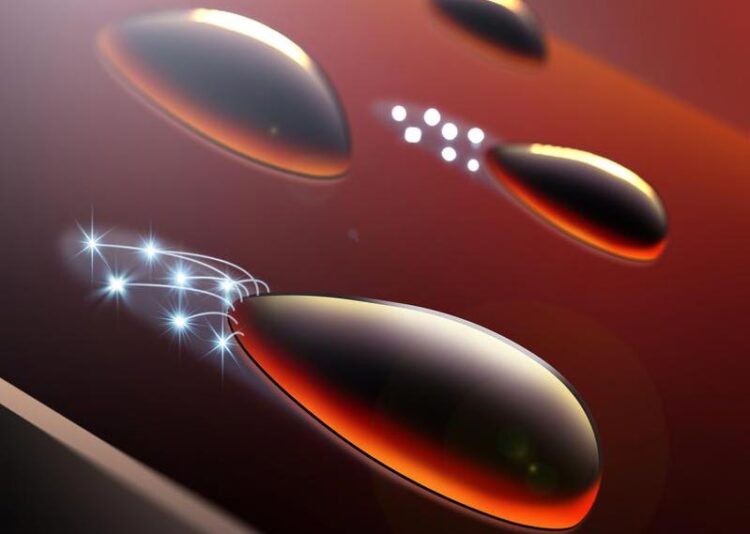Water and electricity: Charge effects can influence flowing droplets

By sliding over surfaces, droplets can leave a trail of electrical charges, which in turn can have a significant influence on their movement.
(c) MPI-P
Droplets sliding over surfaces are relevant for many applications. The movement of the droplets is determined not only by the mechanical properties of the surface. A team led by Hans-Jürgen Butt at the Max Planck Institute for Polymer Research has now discovered that electrical charges also have a significant influence on the movement. This could help to optimize processes involving droplets in the future.
From precise inkjet printing to clear vision through spectacle lenses – the influence of droplets and their movement shapes numerous areas of our daily lives. While droplets should remain precisely in place on inkjet prints, it is desirable that they move quickly across the surface of spectacle lenses. Research into wetting processes therefore plays a crucial role in further improving technological applications.
The interaction between liquids and surfaces depends not only on the properties of the surface, but also on the properties of the liquid. However, a research project initiated at the Max Planck Institute for Polymer Research (MPI-P) has focused on another dimension in recent years: electrical charges. These play a decisive role in the complex wetting processes.
“In our experiments, we have found that a droplet that slides over a surface can leave a trail of electrical charges behind, which then influences the subsequent droplets,” says Hans-Jürgen Butt, Director of the “Physics at Interfaces” department at the MPI-P.
In a new article now published in the journal “Physical Review Letters”, Butt and his colleagues have taken a closer look at the effects of this charge trail on droplet properties. If a droplet slides down an inclined plate, as in the experiment they conducted, the droplets form different angles to the plate surface on their front and back sides. The difference between these two angles – the so-called “contact angle hysteresis” – is significantly altered by the presence of a surface charge.
“We worked with different configurations: Once so that the plate and droplet can charge and once so that only the plate can charge,” says Butt, describing the experiment. On the one hand, they were able to show that charges have an influence on the contact angles and therefore also the wetting behavior, but also that the effect occurs regardless of whether the droplets and/or plate are charged.
The researchers’ investigations contribute to the targeted use of charges in applications to manipulate droplet behavior or to reduce undesired effects that occur due to charges in biochemical analysis using microfluids or during condensation in heat exchangers.
Wissenschaftliche Ansprechpartner:
Prof. Dr. Hans-Jürgen Butt
butt@mpip-mainz.mpg.de
Originalpublikation:
Xiaomei Li, Aaron D. Ratschow, Steffen Hardt, and Hans-Jürgen Butt
Surface Charge Deposition by Moving Drops Reduces Contact Angles
Phys. Rev. Lett. 131, 228201
DOI: 10.1103/PhysRevLett.131.228201
Media Contact
All latest news from the category: Physics and Astronomy
This area deals with the fundamental laws and building blocks of nature and how they interact, the properties and the behavior of matter, and research into space and time and their structures.
innovations-report provides in-depth reports and articles on subjects such as astrophysics, laser technologies, nuclear, quantum, particle and solid-state physics, nanotechnologies, planetary research and findings (Mars, Venus) and developments related to the Hubble Telescope.
Newest articles
Faster, more energy-efficient way to manufacture an industrially important chemical
Zirconium combined with silicon nitride enhances the conversion of propane — present in natural gas — needed to create in-demand plastic, polypropylene. Polypropylene is a common type of plastic found…

Energy planning in Ghana as a role model for the world
Improving the resilience of energy systems in the Global South. What criteria should we use to better plan for resilient energy systems? How do socio-economic, technical and climate change related…

Artificial blood vessels could improve heart bypass outcomes
Artificial blood vessels could improve heart bypass outcomes. 3D-printed blood vessels, which closely mimic the properties of human veins, could transform the treatment of cardiovascular diseases. Strong, flexible, gel-like tubes…





















